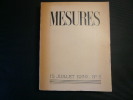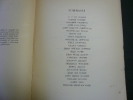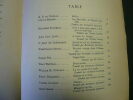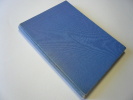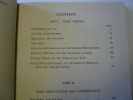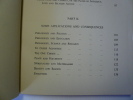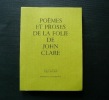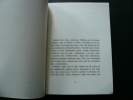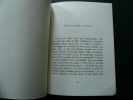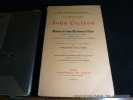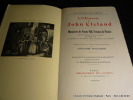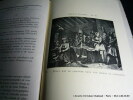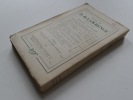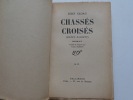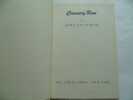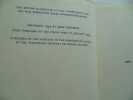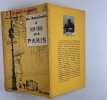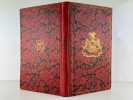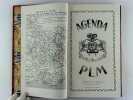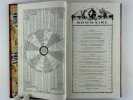22723 books for « ma john »Edit
-
Latest
Last 24h (15)
Last 3 days (15)
Last month (894)
Last week (9)
-
Language
Czech (1)
Dutch (13)
English (299)
French (22238)
German (4)
Greek (6)
Italian (1)
Japanese (1)
Latin (9)
Russian (149)
Spanish (2)
-
Century
16th (4)
17th (72)
18th (345)
19th (1175)
20th (11462)
21st (2086)
-
Countries
Belgium (1642)
Brazil (3)
Canada (219)
China (36)
Côte d'Ivoire (20)
Denmark (445)
France (18397)
Germany (35)
Greece (29)
Italy (90)
Netherlands (1)
Switzerland (1585)
United Kingdom (66)
United States of America (155)
-
Syndicate
ALAC (187)
CLAM (119)
CLAQ (83)
CNE (9)
ILAB (11112)
NVVA (192)
SLACES (191)
SLAM (9769)
SNCAO (19)
Type
- Any type (3)
- Artists book (1)
- Autograph (1)
- Book (22359)
- Disk (13)
- Drawings (1)
- Engraving (12)
- Magazine (13)
- Manuscript (1)
- Maps (17)
- Music sheets (263)
- New book (14)
- Object book (1)
- Old papers (4)
- Photographs (15)
- Postcards (2)
- Posters (3)
Topics
- Africa (51)
- American literature (55)
- Archaeology (102)
- Architecture (172)
- Army (55)
- Belgium (53)
- Biography (132)
- Brunner john (73)
- Buchan john (80)
- Caricature (65)
- Carpenter (190)
- Children’s books (161)
- China (89)
- Christianity (72)
- Cinema (141)
- Comic strip (179)
- Creasey john (82)
- Detective novels (283)
- Dos passos john (108)
- Drawings (63)
- Early printed books (103)
- Economics (153)
- England (178)
- English (841)
- English literature (65)
- Europe (54)
- Fantastic (109)
- Fashion (52)
- Fine arts (221)
- First edition (385)
- Flanders (81)
- Galsworthy john (243)
- Gardner john (53)
- Geography (103)
- Germanic languages (73)
- Gold (57)
- Grand-carteret (256)
- Great britain (79)
- Greece (50)
- Grisham john (199)
- History (788)
- Industrial arts & crafts - fine arts (83)
- Iran - persia (191)
- Irving john (166)
- Knittel john (130)
- Latin (51)
- Law (54)
- Le carre john (137)
- Literature (1992)
- Locke (114)
- Magazine (68)
- Medicine (112)
- Military arts (52)
- Milton john (70)
- Mountaineering climbing (51)
- Music (68)
- Navy (92)
- Newspapers press (79)
- North america (50)
- Ornithology (100)
- Painters (76)
- Painting (94)
- Paris (60)
- Philosophy (335)
- Photography (218)
- Physics (86)
- Poetry (225)
- Policy (89)
- Posters (50)
- Psychology (86)
- Quebec (63)
- Religions (207)
- Review (104)
- Reviews (65)
- Rock (79)
- Rock (70)
- Ruskin john (75)
- Saint john (185)
- Saint john perse (263)
- Science fiction (156)
- Sciences (146)
- Sciences & technique (65)
- Scores (320)
- Songs (252)
- Spying (104)
- Steinbeck john (389)
- Tea (234)
- Theatre (137)
- Theology (102)
- Translation (91)
- Travel (128)
- Turner (54)
- United kingdom (154)
- United states (165)
- Updike john (73)
- Various (128)
- War (269)
- Williams tennessee (61)
- Youth (56)
R. P. du Poisin, Cotton Mather, Benjamin Franklin, John Paul Jones, Saint John de Crèvecoeur, Washington Irvin, Edgar Poe, Walt Whitmann, William H. Herndon, Emily Dinkinson, Vachel Lindsay, James Weldon Johnson, Hart Crane, John Peale Bishop, Langston Hughes, Robinson Jeffers, Archibald Macleish, Henry Miller, Marianne Moore, John dos Passos, John Crowe Ransom, Wallace Stevens, Allen Tate, William Carlos Williams.
Reference : 78781
(1939)
MESURES n°3 15 juillet 1939. Numéro spécial consacré aux LETTRES AMERICAINES.
Paris, José Corti, 1939, 185x23mm, broché, 382p. Bel exemplaire.
GRAVURE : 7. The Ferry-House, at Pantura [Le Ferry-House, à Pantura] TIRÉE DE : Scenery and Reminiscences of Ceylon (Paysages et souvenirs de Ceylan) par John Deschamps, 1844 London by Ackermann & Co., 96 The Strand
London Ackermann & Co 1844 1 planche lithographiée en couleur d'après Deschamps, imprimée sur papier épais crème, format : 47 x 31 cm, TIREE DE : Scenery and Reminiscences of Ceylon (Paysages et souvenirs de Ceylan) par John Deschamps, 1844 London by Ackermann & Co., 96 The Strand
Un aperçu important et ambitieux du Sri Lanka du milieu du XIXe siècle Par Deschamps. gravure, d'après un dessin original et des notes prises par lui pendant un service de neuf ans, en tant qu'officier de l'artillerie royale dans cette île ... Reference: Abbey Travel 414 ...... RARISSIME .... en trés bon état (very good condition).TITLE: Scenery and Reminiscences of Ceylon en trés bon état
SHEFFIELD, John ; DUC DE BUCKINGHAM ET DE NORMANBY + RERESBY, John
Reference : 26156
(1824)
MÉMOIRES DE SIR JOHN RERESBY + MÉMOIRES DU DUC DE BUCKINGHAM.
Paris Rouen Béchet aîné 1824 -in-8 demi-Maroquin 2 parties et 1 volume, reliure demi-maroquin (binding half red morocco) rouge in-octavo, RELIURE D'ÉPOQUE, dos 5 nerfs (spine with raised bands), décoration "or" et à froid (gilt and blind stamping decoration), Titre Général et Titre des 2 Mémoires frappés "or" (gilt title) dans un encadrement d'un filet "or", entre-nerfs à caisson formés de deux filets fins "or" en encadrement, filet perlé "or" en place des nerfs avec un filet à froid de part et d'autre des nerfs, lieu et date frappés "or" en pied dans un encadrement d'un filet fin "or", papier marbré rouge, marron-foncé et marron-clair aux plats, toutes tranches lisses jaspées bleu, blanc, rouge, EX-LIBRIS AUX ARMES gravé en noir sur une étiquette ronde au dos de la 1ère de couverture : Bibliothèque du BARON JAMES DE ROTHSCHILD [Le baron Jacob Mayer de Rothschild, dit James de Rothschild, né le 15 mai 1792 à Francfort-sur-le-Main (Saint-Empire) et mort le 15 novembre 1868 à Paris (9e), est un banquier allemand, fondateur de la branche de Paris de la famille Rothschild. Arrivé à Paris en mars 1811, afin de créer la filiale française de la « maison Rothschild », James installe en 1815, après avoir spéculé sur la chute de l'Empire, l'établissement financier « MM. de Rothschild Frères ». Il participe avec sa famille au financement de l'effort de guerre de la coalition menée par la Grande-Bretagne contre Napoléon Ier, et celle-ci terminée, parviendra à retrouver les faveurs du gouvernement français, d'abord en procurant à Louis XVIII les cinq millions de francs « nécessaires à la dignité de son retour », puis fréquentant assidûment le duc de Richelieu. Il aidera le gouvernement de la Restauration, puis celui de la monarchie de Juillet, et gèrera la fortune personnelle du roi des Français Louis-Philippe Ier. Il financera également lÉtat belge nouvellement indépendant, lIndépendance grecque, lUnité italienne, secourt les trésoreries de lEspagne, de lAutriche et des États-Unis. ], avec en haut à gauche une Etiquette Rectangulaire imprimée en noir : FERRIERES (Chateau de FERRIERES (Le château de Ferrières, situé en Seine-et-Marne sur les communes de Ferrières-en-Brie pour son bâti et de Pontcarré pour son parc à l'anglaise, a été aménagé à partir de 1829 par Joseph Paxton pour le baron James de Rothschild), sans illustrations (no illustration) excepté une marque gravée en noir de l'Editeur en bas de la page de titre, (VII+343) + (58) pages, 1824 à Paris et Rouen : Béchet aîné Editeur,
Note : Collection des Mémoires relatifs à la Révolution d'Angleterre. XXI. - La 2e partie a un titre propre qui porte : "Mémoires du duc de Buckingham sur le règne de Charles II et la révolution de 1688"..... TRÉS BEL EXEMPLAIRE .... DE TRÉS BELLE PROVENANCE ..... en trés bon état (very good condition). en trés bon état
John Rocque Map of the Post Roads of Europe - CARTE GENERALE DES POSTES DE L'EUROPE : dans laquelle en a tracé toutes les routes, et marqué toutes les places où la poste et établie, Par le Sr. Rocque Topographe de Sa Majesté, Britannique
Londres Robert Sayer 1773 une carte géographique dépliante entoilée saumon, CARTE D'EPOQUE, format plié : 16 x 22 cm, format déplié : 84 x 90 cm, Publié à Londres par Robert Sayer en 1773 et gravé par J. Gibson, il s'agit d'un bon exemplaire de la "Carte des routes de l'Europe de John Rocque". Rocque fut l'un des cartographes les plus importants de son époque. tissu et disséqué en vingt-quatre sections et conserve son étui d'origine la carte mesure 84 x 90 cm. avec une coloration à la main originale, la carte est en bon état, L'etui d'Epoque (16 x 22 cm) recouvert de papier marbré peigné orange est orné en son centre (partie haute) d'une pièce de titre sur fond vert avec roulette "or" en encadrment, titre doré "ROUTES D'EUROPE", plats et dos de l'étui dans un encadrement d'une roulette "or", l'or à terni légèrement mais l'étui est superbe, Bel exemplaire finement aquarellé à l'époque. 1773 Londres Robert Sayer Editeur,
Bon Exemplaire de cette carte recherchée de Rocque avec son trés Bel Etui..........TRES RARE dans un tel état de fraicheur des couleurs. .........SUPERBE......en bon état (good condition). parfait état
Plate. 28. : PUNISHMENT OF THE TCHA [le supplice de la La cangue (ou TCHA)], gravure tirée de : Lord Macartney's Embassy to China, Published in London, 1796. [ Macartney, George (1737-1806) : An Authentic account of an embassy from the king of Great Britain to the emperor of China... taken chiefly from the papers of... the earl of Macartney... by Sir George Staunton.. London : G. Nicol, 1796]
London G. Nicol 1796 une gravure ancienne dessinée par William Alexander et gravée en noir par John HALL, Format : 38 x 31 cm, Plate. 28. : Punishment of the Tcha [le supplice de la La cangue (ou TCHA)], gravure tirée de : Lord Macartney's Embassy to China, Published in London by G. Nicol, 1796.
Engraving recording a journey through China .....le supplice de la La cangue (ou TCHA), est un châtiment similaire au pilori en Occident, à la différence que la planche de la cangue n'était pas fixée à une base et devait être portée par le prisonnier ....... L'Ambassade de Lord Macartney, mission britannique qui s'est rendue en Chine en 1792-1793 pour tenter d'obtenir des relations commerciales et diplomatiques plus favorables pour le Royaume-Uni. Dirigée par George Macartney, elle a été envoyée par le roi George III auprès de l'empereur Qianlong. La mission a été marquée par une série de malentendus entre les Britanniques et les Chinois, et l'État Qing a finalement rejeté toutes les demandes britanniques, un résultat qui s'est avéré être l'un des facteurs qui ont contribué au début des guerres de l'opium au XIXe siècle ...... superbe GRAVURE ......... en trés bon état ( very good condition). William Alexander, engraved by John Hall. trés bon état
PHOTOGRAPHIE ORIGINALE : Temple Gate, Shanghai; Attributed to John Thomson (Scottish, 1837 - 1921); Shanghai, Kiangsu, China; 1870; Albumen silver print
PEKIN 1860 une photographie originale : photographie positive montée sur carton : papier albuminé, d'après négatif sur plaque de verre au collodion, format de la photo seule : 21 x 27,5 cm, photographie du Temple Gate, Shanghai; Attributed to John Thomson [1870]
TRES RARE ....... en trés bon état ( very good condition). en trés bon état
Immediate Knowledge and Happiness - Non-Dualistic Vedanta, Its Doctrine, Practice & Some General Applications. JOINT : Le Védanta et René Guénon par John Lévy (24p.)
London , John Lloyd, 1951, 19x25cm, hardcover, no dustjacket, 149p. First edition. Annotations au crayon dans la marge, sur le 47 premières pages.
Poèmes et proses de la folie de John Clare, suivis de La psychose de John Clare, par Jean Fanchette.
Paris, Mercure de France, 1977, in-4, broché, 154p. Bon état.
Les Prêtres-Rois de Gor. Les Nomades de Gor
Paris, Ed. Opta. Aventures fantastiques. N°20, 1979, in-8°., Relié-Jaquette éditeur, 640 pages. Jaquette défraîchie présentant de petits frottements en tête et pied. Coprs d'ouvrage très légèrement gauchi. Bon état de la couverture toilée et de l'intérieur. Réalisé d'après les maquettes de Juliette Weingand et illustré de dessins originaux de Philippe Adamov. Exemplaire n°1711/3000
L'Oeuvre de John Cleland. Mémoires de Fanny Hill, Femme de Plaisir. Avec des documents sur la vie à Londres au XVIIIe siècle et notamment la Vie galante d'après les Sérails de Londres. Introduction et essai bibliographique par GUILLAUME APOLLINAIRE. Ouvra
Paris, Bibliothèque des Curieux, Les Maîtres de l'Amour, 1932, in-8°., Broché, 268 pages. Très bon état. L'Oeuvre de John Cleland. Mémoires de Fanny Hill, Femme de Plaisir. Avec des documents sur la vie à Londres au XVIIIe siècle et notamment la Vie galante d'après les Sérails de Londres. Introduction et essai bibliographique par GUILLAUME APOLLINAIRE. Ouvrage orné de 65 compositions d'après William Hogarth. Introduction suivi d'un essai bibliographique.
LE PARADIS PERDU [de John Milton], traduction nouvelle et complète en vers français ; par J.-V.-A. Delatour de Pernes
Paris impr. de A. Égron 1813 -in-8 demi-veau un volume, reliure demi-veau glacé havane in-octavo (binding half calfskin in-8)(20,7 x 13 cm), RELIURE D'ÉPOQUE , dos long (spine without raised bands), décoration "or" (gilt decoration), Titre frappé "or" avec un filet large "or" de part et d'autre du titre, entre-nerfs à fleuron "or" avec un filet large "or" de part et d'autre, 4 filets fins "or" bordés d'un filet large "or" de part et d'autre en place des nerfs et en tête et en pied, roulette "feuillage" large "or" en pied, papier peigné marron, rouge et noir aux plats, pages de garde peignées à motif "caillouté" (painting flyleaf), avec la signature manuscrite de l'Auteur à l'encre brune au dos de la page de faux-titre, sans illustration (no illustration), II + 376 pages, 1813 à Paris impr. de A. Égron Editeur,
Autre auteur : Delatour de Pernes, J.-V.-A.. Traducteur .....TRES BEL EXEMPLAIRE ....d'une RARE TRADUCTION....... en bon état (good condition). en bon état
LES IMAGES GALANTES publiées sous la direction de John Grand-Carteret, ESTAMPES CELEBRES DE NOS PLUS GRAND MAITRES DES XVIIe, XVIIe & XIXeme Siècles - Contes et récits Paillards, Musique du bon vieux temps, Chansons Gaies, Badines et Grivoises - DEUXIEME SERIE
Paris LIBRAIRIE ARTISTIQUE 1909 in-4 broché un volume, broché in-quarto Editeur (paperback in-4 editor)(30 x 22,8 cm), dos et couverture marron clair imprimés en noir, 1ère de couverture illustrée d'un encadrement art-nouveau en noir, Edition ornée de nombreuses gravures in et hors-texte en noir et en couleurs, 2ème Série : 192 pages, sans date (1909) à Paris LIBRAIRIE ARTISTIQUE Editeur,
BEL EXEMPLAIRE.......RARE...en trés bon état (very good condition). en trés bon état
Thomas John Alcorn - New-York 28-4-56 Firenze 13-3-1974
New-York, Rizzoli , 1976, in-4, broché, np. Bon état. Nombreuses illustrations N/B
John Gloag. Chassés croisés : Sweet Rackett, roman, traduit de l'anglais par Sabine Berritz
Paris, Gallimard, 11 avril 1939, in-12, broché, 215p. Exemplaire du service de presse. Bel exemplaire.
PORTFOLIO COLONIAL DEPEIGNANT LES PAYSAGES LES VILLES ET LES INDUSTRIES DES POSSESSIONS ET DEPENDANCES FRANCAISES AINSI QUE DES PAYS QUI QUOIQUE N'ETANT PAS EFFECTIVEMENT SOUS NOTRE PROTECTORAT FONT NEANMOINS PARTIE DE LA FRANCE COLONIALE, EN RAISON DE LEURS MOEURS LEURS TRADITIONS ET LEUR LANGAGE, Photographies rassemblées par John L. Stoddard.
paris The Werner Company de Chicago 1895 -in-4 demi-basane 1 volume, reliure demi-basane rouge in-quarto à l'italienne (half binding sheepskin in-4 oblong) (27,5 x 34,5 cm), Reliure d'Epoque, dos à nerfs (spine with raised bands), décorations "or" et à froid (gilt and blind stamping decoration), Auteur et titre frappés "or", entre-nerfs à fleuron "or", filet à froid de part et d'autre des nerfs, papiermarbré rouge, marronj et noir aux plats, toutes tranches lisses, preface sur 2 pages + 192 pages de photographies légendées en bas, 192 pages, 1895 à Paris The Werner Company de Chicago Editeur,
2 pages de Préface; Photo 1. Le temple de Pondichéry; Photo 2. Les coupeurs de cannes à sucre; Photo 3. Les Papous;Photo. 4. Montréal; Photo 5. Le champ de courses d' Anoï; Photo 6. Les bambous de la côte de Coromandel; Photo 7. Alger; Photo 8. Les chercheurs d'or; Photo 9. Les pêcheurs primitifs; Photo 10. Les quais de Suez; Photo 11. Un camp Indien; Photo 12. La mission Sainte-Barbe; Photo 13. Le pont couvert de Son-Tay; Photo 14. Les Mille-Iles; Photo 15. Les fougères géantes; Photo 16. Les murs en poterie; Photo 17. Les rues de la vieille ville d'Alger; Photo 18. Montréal sous la neige; Photo 19. Le rémouleur du Caire; Photo 20. Le chemin de fer à crémaillère; Photo 21. Le monument de Washington; Photo 22. Le palmier géant [Ravelana Madagascariensis appelé l'arbre du voyageur]; Photo 23. Le mystère architectural; Photo 24. Les champignons fantastiques; Photo 25. La mosquée de Sidi-Abder-Khaman; Photo. 26. Le geyser Waikite; Photo 27. Les geysers du parc de Yellowstone; Photo 28. La ville de Bac-Ninh; Photo 29. La grande cascade; Photo 30. Le Grand Cañon; Photo 31. Le moulin Robert; Photo 32. La cathédrale de Saint-Patrick; Photo 33. Les gorges de la Chiffa; Photo 34. Les marchandes de légumes, à Suez; Photo 35. Le Niagara en hiver; Photo 36. La chute Américaine; Photo 37. Le Fer à Cheval; Photo 38. Les rochers Amonceles; Photo 39. Les rapides; Photo 40-41. Le pont suspendu du Niagara; Photo 42. Au claire de lune; Photo 43. L'aspect général du Niagara; Photo 44. Le côté Méridional;Photo 45. Le pont des Trois-soeurs; Photo 46. Les chutes de Juanacatlau; Photo 47. La pagode de Bouddha; Photo 48. Les chutes de Shoshone; Photo 49. La préparation du riz; Photo 50. Les cotons en partance; Photo 51. Le pavillon de l'Eloquence à Bac-Ninh; Photo 52. Un quartier nègre; Photo 53. L'Observatoire de Lick; Photo 54. La boucle de Mauch-Chunk; Photo 55. La vallée du Sind; Photo 56. Les quais de Cincinnati; Photo 57. La jolie ville de Blidah; Photo. 58. La Gorge de Crawford; Photo 59. Les hôtels de la presse; Photo 60. Le pic de Mitre; Photo 61. Les fumeurs d'Opium; Photo 62. Pittsbourg; Photo 63. Le siège du gouvernement à Nassau; Photo 64. Le mont Ross; Photo 65. L'Algérien; Photo 66. La chute de l'Oiseau; Photo 67. Les prisonniers Malgaches; Photo 68. La rue Collins; Photo 69. La colonne d'Hercule; Photo 70. Le rocher Pupitre; Photo 71. La vallée Mystérieuse de Watkins; Photo 72-73. La porte-d'Or; Photo 74. Les cueilleurs d'oranges; Photo 75. Québec; Photo 76. Le lac Wesley; Photo 77. L'allée des palmiers; Photo 78. Le jardin des Dieux; Photo 79. Les tisseuses Malgaches; Photo 80. La baie de New-york; Photo 81. Le groupe de Bourjanes; Photo 82. L'hôtel Banff; Photo. 83. Les villages Lacustres; Photo 84. Chapultepec; Photo 85. Le lac George; Photo. 86. Le marché;Photo 87. Sur la côte-d'Ivoire; Photo 88. Lucknow; Photo 89. La vieille mission; Photo 90. Les appareils de justice; Photo 91. l'église de San-Miguel; Photo 92. Maestri; Photo 93. Les Indiens Zuni; Photo 94. Ce groupe de Canaques; Photo 95. Un buffet; Photo 96. Le Derby; Photo 97. Le type de créole; Photo 98. L'hôtel Ponce de Léon; Photo 99. Les pics Espagnol;Photo 100. Le lac du Diable; Photo 101. Les Filanzames; Photo 102. Le palais National; Photo 103. Kingston; Photo 104. L'Ocklawaha; Photo 105. Le roi de Tsialan; Photo 106. La Grande Rue; Photo 107. Une hutte d'Indiens; Photo 108. Une ferme au canada; Photo 109. Nos soldats au Dahomey; Photo 110. La route des forçats; Photo 111. La Porte de l'Enfer;Photo 112. Le mont Shasta; Photo 113. La séance de Sikidi; Photo 114. Le chemin de fer d'Oroya; Photo 115. Le popocatepetl; Photo 116. La passe des Sioux; Photo 117. Le campement de la mission Binger; Photo 118. Le lac Tahoe;Photo 119. Le tombeau; Photo 120. La rue du Canal; Photo 121. Les Toucouleurs; Photo 122. Une lagune en Nouvelle-Calédonie; Photo 123. Ce campement de Canaques; Photo 124. Notre-Dame-de-Guadeloupe; Photo 125. La maison du Quaker; Photo 126. Les chutes du Kootenai; Photo 127. Ces pirogues; Photo 128. Le parc Washington; Photo 129. Les sept Châteaux; Photo 130. Les trois frères; Photo 131. Le lac Miroir; Photo 132. La maison du Lierre; Photo 133. Santiago;Photo 134. Cette Arche; Photo 135. La mosquée de Bondoukou; Photo 136. Le château de Roc; Photo 137. Les montagnes de San Francisco; Photo 138. Un village Indien; Photo 139. L'hôtel Coronado; Photo 140. L'avenue des Cèdres; Photo 141. La route d'Ormond-sur-Halifax; Photo 142. Le pont de Hawkesbury; Photo 143. Betsimisaraka; Photo 144. La maison de la Fayette; Photo 145. Ce métier de tisserand de la Côte-d'Ivoire; Photo 146. Le temple Maçonnique; Photo 147. L'église de la très-Sainte-Trinité; Photo 148. L'étang du Diable; Photo 149. La chute de Multnomah; Photo 150. Le pic Pike; Photo 151. La chute de Nevada; Photo 152. Les indigènes de l'Australie; Photo 153. Ce village Agui; Photo 154. La maison de l'heureux Baldwins; Photo 155. Les pics du Corolado; Photo 156. La vie au Mexique; Photo 157. La mission de Saint-Louis; Photo 158. Les habitations du Mexique; Photo 159. Le Switch-Back; Photo 160. Le lac Rouge; Photo 161. Ces fétiches grossiers; Photo 162. La cour du collège Howard; Photo 163. La rue du Canal; Photo 164. La rue du Marché, à San-Francisco; Photo 165. La ville de Denver; Photo 166. La vallée Rocheuse; Photo 167. Hamilton; Photo 168-169. Le Cap; Photo 170. Le lac Ivanhoë; Photo 171. La ville de Saint-Pierre; Photo 172. L'Illiciwaet; Photo 173. Mexico; Photo 174. La rade de Nouméa; Photo 175. La grande vigne de Santa-Barbara; Photo 176. La rivière de l'Arc; Photo 177. Les plantes de la forêt, sur la Côte-Ivoire; Photo 178. Les traineaux de chiens; Photo 179. La cap Trinité; Photo 180. Le fort de Saint-Jean d'Ulloa et la ville de Vera-Cruz; Photo 181. Le chemin de fer de Valparaiso à Santiago; Photo 182. La cuisine indienne; Photo183. La Grande Rue de los Angeles; Photo 184. La cour intérieure d'une maison, à Mexico; Photo 185. Le port d'Alger; Photo 186. Le Pélerin; Photo 187. Sitka, capitale de l'Alaska; Photo 188. Les chutes de Fitzroy; Photo 189. Wellington; Photo 190. Cette rivière de l'Ile Maurice; Photo 191. Leadville; Photo 192. Broadway;......en bon état (good condition) bon état
Mon grand ami Shakespeare. Souvenirs de John Lacy comédien du Roi reconstitués par Longworth Chambrun.
Paris, Librairie Plon, 1935, in-12, Broché, 307 pages. Bon état.
The Works of William Hogarth; with Descriptions, and A Comment on their Moral Tendency by the Rev. John Trusler, to which are added, anecdotes of the Author and His Works, by J. Hogarth and J. Nichol. Vol. 1
London, Jones & Cie, 1833, 55 engravings. Full leather. Plein veau. Quelques frottements sur la reliure. Rousseurs.
Cannery Row.
New York, The Viking Press, 1945, in-12, blue hardcover (without dustjacket), 181 pages. Good condition. The copyright page shows Copyright 1945 by John Steinbeck
ST JOHN DE CREVECOEUR, J. Hector (CREVECOEUR MICHEL GUILLAUME SAINT JEAN)
Reference : 16999
(1784)
LETTRES D'UN CULTIVATEUR AMERICAIN, ECRITES A W. S. ECUYER, DEPUIS L'ANNEE 1770, JUSQU'A 1781. TRADUITES DE L'ANGLOIS PAR ***.
1784 2 volumes, reliure demi-veau havane moucheté in-octavo (binding half calfskin in-octavo) (12,5 x 19,8 cm), reliure d'époque, dos long (spine without raised band), décoration or (gilt decoration) et à froid (blind stamping décoration), à filets à frois, roulettes et fleurons à froid (gilt lines) , pièce de titre sur fond bordeaux avec filet à froid (label of title with blind line) et pièce de tomaison sur fond noir avec filet à froid (label of volume numbering with blind line), papier fantaisie jaune d'époque aux plats (cover with imagination paper), toutes tranches lisses (all smooth edges), jaspées bleues, sans illustrations hormis une vignette gravée sur bois en noir (engraving wood) en bas de la page de titre différente pour chaque tome, pièces de titres restaurées, léger trou de ver en marge des premières pages du tome 2, xxiv, iij (1) 422pp. (2) et (2) iv, 400pp. (2)., 1784 Paris chez Cuchet Editeur,
Edition originale française. La première édition étant parue à Londres, en anglais, en 1782. L'édition française a cependant été refondue, corrigée et traduite par l'auteur lui-même, qui lui a ajouté un second volume, et s'est même permis de changer le nom du narrateur james en son propre nom. En outre l'édition française est plus nettement anti anglaise et pro américaine.....Note(s) : Ecrit et traduit par Saint-John de Crèvecoeur. Avec des Lettres servant d'introduction, par Lacretelle ..................Crèvecoeur (1735-1813) se rendit en Nouvelle France en 1755 en tant quofficier et géographe durant les guerres françaises et indiennes. Il combat auprès des français, puis voyage beaucoup et devient finalement fermier dans les colonies anglaises. Il se fit naturalisé, puis la révolution américaine le fit rentrer en France. Lorsquil revint en 1783, il découvrira que sa ferme a été ravagée, sa femme tuée, et deux de ses enfants disparus. Au niveau de lagriculture il introduira la culture de la pomme de terre en Normandie, et celle de la luzerne aux États unis. Les lettres sont à la fois des récits de voyages et le premier ouvrage décrivant la vie américaine, la vie quotidienne, léducation et les moeurs, par non plus seulement un voyageur, mais un homme dexpérience ayant observé et partagé la vie des américains. Le livre contribua à forger limage dune identité américaine, fondée sur lingéniosité, la liberté et légalité. Nombre de familles françaises sembarqueront pour lAmérique après la lecture de ce livre. Louvrage ne sattache pas seulement à louest américain, de nombreuses pages sont consacrées au Canada, Terre Neuve... On trouve également des articles sur Washington, Franklin et des remarques sur la guerre dindépendance, lesclavage, et de nombreuses anecdotes. Louvrage est dédié au marquis de La Fayette................RARE............en bon état malgré le petit défaut signalé (good condition in spite of the small defect indicated)..
Epigrammatum Joan. Owenii, cambro britanny oxoniensis, editio postrema, correctissima et posthumis quibusdam adaucta
1647 reliure plein maroquin rouge in-trente-deux (binding full red morocco in-32) (10,5 x 6,4 cm), dos long décoré "or", compartiments à fleuron or au centre avec des feuillages or exécutés aux filets courbes aux angles, titre frappé or, pièce de titre sur fond vert cernée d'un double filet or (label of title with double gilt line) , double filets or en place des nerfs, en pied il ya une pièce avec date et nom de l'éditeur frappés or sur fond vert cernée d'un double filet or , plats ornés d'un encadrement à triple filets dorés avec un fleuron à chaque coin, chiffre A. S. (ex-libris) doré au centre des plats, filet or sur les coupes (gilt line on the cuts) et dentelle sur les chasses (lace-like decoration on the turn-ins), toutes tranches dorées , marque-page en tissu vert, Texte en latin, orné d'un portrait gravé sur bois en noir de John OWEN en frontispice + un titre gravé sur bois en noir + un bandeau, 212 pages , 1647 Amsterodami : apud L. Elzevirium (ELZEVIR) Editeur,
"..Il y a beaucoup de génie dans la plupart des épigrammes d'Owen ; on y trouve de la force , de la cadence & de l'harmonie, de la douceur & de l'enjoûment...".Première des trois Editions parues sous cette date, Reproduit également, à la suite des précédentes Editions Elzeviriennes, des épigrammes qui ne sont point d'Owen et insérées au milieu du volume (P. [107]-120) ; ces pièces, au nombre de 128, improprement intitulées, sont tirées textuellement des "Disticha de moribus" de Michel Verino (Willems 299)....Brunet IV - 300/301.....RARETE.....LIVRE PRECIEUX ....en bon état (good condition).
Biobibliograffiti
Paris 1986, 16,5 x 17 cm, broché, np. Cette première édition de Biobibliograffiti a été tirée à 130 exemplaires (n°90). Elle recycle le texte de Biobibliographique, publié par Kickshaws, dans une édition comprenant une suite de gravures de Dan Sabatay (14).
Le monde selon Garp (The world according to Garp)
Paris Aux Editions du Seuil 1980, in-8, broché, 582p. Légers plis de lecture au dos. Bon état.
Un Américain à New-York et à Paris.
Paris Julliard 14 mai 1956, in-12, broché, couverture à rabats, 154p. Edition originale sur papier d'édition. Couverture de Lars Bo. Bon état.
- Collectif. Textes de Colette, Louis Bertrand, Jules Véran, John Grand-Carteret, Henri Cain, Georges Rozet, Gabriel Boissy, Marius André, Gaston Leroux, Yvanhoé Rambosson, Raoul Vèze, Gabriel Volland, Germaine Acremant, Paul Souchon, Noël Thiollier, M. Roux--Servine
Reference : 84520
(1925)
Agenda des Chemins de Fer PLM 1925. Paris - Lyon - Méditerannée.
Paris P.L.M, 1925, in-4 oblong (29x17cm), demi-reliure éditeur, 303p. Très bon état. Hors-texte en couleurs. Sans annotations.
 Write to the booksellers
Write to the booksellers